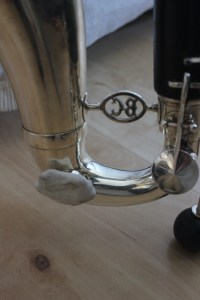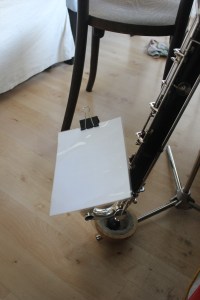I started thinking more seriously about preparing the bass clarinet after Aaron Einbond used it in his (awesome) piece, Resistance, for prepared bass clarinet and live electronics. I originally assumed that it wouldn’t be so useful: one can only prepare the bass clarinet by preparing the bell, and therefore only the lowest note (the written C) is affected. That said, there are actually a lot of different things one can use to prepare the bass clarinet with, and a lot of interesting sound material one can develop by making use of these preparations. So grab some good headphones, or good speakers as there are a load of audio examples in this post and my laptop speakers at least aren’t really up to them…
A few things to remember:
- Changing preparations takes a little time. I’d say probably a little more time than changing from Bb to A clarinet, as one has to be quite careful in most cases that the preparation is properly covering the bell.
- I’ve never managed to find a way to change preparations while standing. It’s totally awkward to try to reach for the bell while harnessed into the instrument, and always seemed like too much of a risk to take the instrument out of the harness in the middle of the piece. So I’ve always had to play Einbond’s piece sitting down.
- Make sure the clarinetist in question is okay with having various things attached to the bell, or put inside the bell. My ratty old bell doesn’t seem to mind it and I’ve never scratched it or needed any kind of repair because of my preparation experiments, but its possible not everyone will feel the same way I do.
- Bluetack is your friend. This is what I use to seal the vent hole, and it’s what I use to protect the instrument from the metal edges of the bulldog clip. If you’re a composer, bring some along when you want to try these things out with a clarinetist.
- When I talk about opening and closing, or sealing, the vent hole, this is what I’m talking about:
- If the clarinetist has never manually covered the vent hole in performance before, it takes a little practise to get used to where it is. You can have socks on, but it doesn’t work with shoes. I generally aim to shove the joint of my big toe into the vent hole. If the vent hole needs to be covered for the duration of the piece, it can be done so with bluetack or whitetack or some other similar substance:
And now for the preparations…
Plastic
This preparation (as used by Einbond) is a piece of normal weight paper, laminated. As with the card preparation, its fixed to the bass clarinet with a bulldog clip (the bass clarinet can be protected by gluing felt to the metal edges of the clip or by using bluetack).
Here’s what the preparation sounds like, on its own, played with a crescendo and diminuendo. Notice how (and I think this is true of most of the preparations) the vibrations increase to a certain point; once passing that point, the vibrations don’t increase anymore, but the clarinet sound continues to grow.
And now in this example, I slowly close and open the vent hole, which increases the action of the preparation while also lowering the pitch, about a quarter tone: [
Now, with flutter tongue and the closing and opening of the vent:
Now, with singing and the closing and opening of the vent:
And finally, singing, closing the vent and then using the embouchure to further lower the pitch. This is quite extreme, I rather like this one:
Paper
This isn’t actually paper. It needs to be a bit harder than that, a sheet of card. It’s actually not so easy to find the right balance, so having a few different thicknesses to try is probably not a bad idea. Do compare this with the sound of the plastic, however, it’s striking how different a sound world it creates, I think.
Normal crescendo decrescendo. I should say as well, that it’s quite fantastic what a rumbling you can create, even without any clarinet tone at all:
And now here with the vent covering. The card is much more strongly activated this way, also when compared with the plastic:
And now flutter and the vent hole:
Singing and the vent hole:
Singing, bending and the vent hole (what a noise!):
Of course preparations of the lowest note can be combined with other things, such as spectral multiphonics:
And slap tongue:
Aluminium Foil:
Don’t forget, when using aluminium foil it makes noise all the time, so best to build that into the piece somehow, if the clarinetist is ever going to change the preparation. It’s also best to always use a new sheet of the foil, as once it’s crumpled up it doesn’t make much noise.
Normal crescendo decrescendo:
With the vent hole:
With flutter and the vent:
With singing and the vent:
Singing, bending and the vent:
Saran wrap / Cling Film:
This isn’t particularly effective. It only seems to work if its drawn extremely tightly across the bell and then play in a forte dynamic:
Tin Can:
I first saw Tim O’Dwyer do this. His preparation seemed to work a little better, but I think I remember him saying that it took him awhile to find the ideal can. It might be the best option if you want a preparation that’s fairly quick to put in and remove. Nothing needs to be clipped and it doesn’t make noise in itself the way the foil does. Anyway, it sounds a little bit like this. When the tin can sound stops, I’m just halting the vibration with my foot while allowing the clarinet sound to continue.
Water
Okay, this is probably the most fun thing ever. But it’s also super important to check with the clarinetist and not assume they’ll be okay with doing this. You don’t need a lot of water, but if you have a vent hole on the bass clarinet in question, it’ll need to be sealed (this is where your handy bluetack comes in!). Once the vent is sealed, add just enough water to rest in the bottom of the bell. Too much, and it’ll start to leak out of the low C tone hole. I’d suggest putting some towels down in case this happens, as it might do once playing begins. A bit of splashing will happen anyway, especially if you use slap tongues.
Here’s what happens if I play at a fairly normal dynamic (but notice the almost near complete lack of pitch):
Now here if I play forte, finally the pitch starts to come through, but distorted:
With flutter tongue, more pitch and it starts to become wild:
If I introduce the voice, multiphonics start to happen, I can’t really stop them from occurring (nor did I want to when I recorded this):
And finally, some slap tongues. The floor was soaked after these…
What also works very nicely that I discovered quite recently is the combination of the water and aluminium foil preparations:
Things I’ve tried that haven’t worked:
- Bubble wrap
- Light paper
- Loose plastic
- Any kind of small objects in the bell (with the idea they might rumble around)
Any questions? If you haven’t been to the blog before, be sure to check out my other posts on clarinet writing.
Find the blog useful? Please consider supporting it:










Leave a Reply to Nicolas Mondon Cancel reply